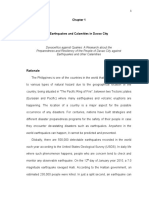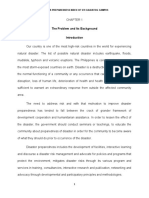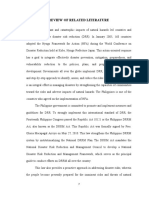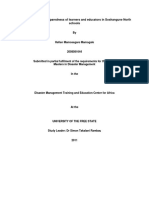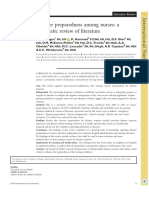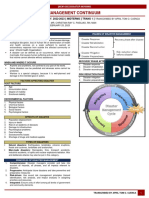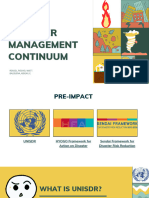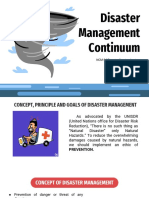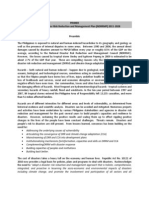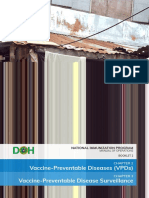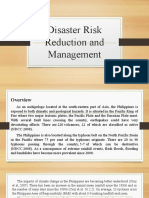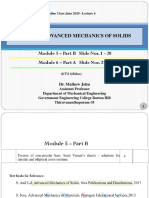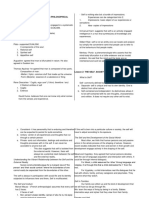Conceptual Framework of Disaster
Conceptual Framework of Disaster
Uploaded by
Bayu Kurnia AdhiCopyright:
Available Formats
Conceptual Framework of Disaster
Conceptual Framework of Disaster
Uploaded by
Bayu Kurnia AdhiOriginal Description:
Copyright
Available Formats
Share this document
Did you find this document useful?
Is this content inappropriate?
Copyright:
Available Formats
Conceptual Framework of Disaster
Conceptual Framework of Disaster
Uploaded by
Bayu Kurnia AdhiCopyright:
Available Formats
PART II
CONCEPTUAL
FRAMEWORK OF
DISASTERS
S S S
Chapter Three
OVERVIEW AND CONCEPTS
ABSTRACT
It is not possible for persons within and between the many disciplines involved in disasters to communicate with each other without clear definitions
of the specific terms that are used. In many instances, the same terms have
different meanings in different disciplines. Thus, a standardized set of definitions is provided in this chapter and in the associated Glossary of Terms.
Some definitions discussed in this Chapter include: (1) disaster; (2) medical
disaster; (3) hazard; (4) risk; (5) prevention; (6) modification; (7) event
(including onset, duration, amplitude, intensity, scale, and magnitude); (8)
impact; (9) mitigation; (10) preparedness; (11) damage; (12) vulnerability;
(13) resilience; (14) absorbing capacity; (15) buffering capacity; (16) disaster management; (17) response; and (18) recovery. An annotated, comprehensive set of definitions is provided in the Glossary of Terms in these
Guidelines.
Keywords: absorbing capacity; amplitude; buffering capacity; damage; definitions; disaster; duration; event; hazard; impact; intensity; magnitude; management; medical disaster; mitigation; modification; onset; preparedness;
prevention; recovery; resilience; response; risk; scale; vulnerability
TFQCDM/WADEM: Health Disaster Management: Guidelines for
Evaluation and Research in the Utstein Style. Chapter 3: Overview
and concepts. Prehosp Disast Med 2002;17(Suppl 3):3155.
31
HEALTH DISASTER MANAGEMENT
Guidelines for Evaluation and Research in the Utstein Style
T IS NOT POSSIBLE to discuss disasters without clear definitions of
specific terms that are used within this document. In the development
of these Guidelines, it became clear that terms used in discussing disasters and the responses to them often are unclear and the meanings given
were not adequate to facilitate understanding of the discussion. In many
instances, the same terms have different meanings in different disciplines.
Thus, for the sake of clarity, many of the definitions used in this document
are included in this Chapter or in the Glossary of Terms. It is an objective of
these Guidelines to establish a standardized vocabulary for future research
and evaluations that utilize these Guidelines for the conduct and reporting
of such studies. There is no assumption that the manner in which the terms
as used in this document, will be accepted universally by the entire disaster
community. However, for consistency and reproducibility, and hence, external validity, any future studies that use these Guidelines and their Templates
should adhere to the definitions as presented in this document.
DISASTER
There are many definitions of a disaster, and these definitions have been discussed in detail by Al-Mahari and Keller.1 The definitions used seem
dependent upon the discipline using the term. No definition of disaster is
accepted universally. In the course on Disaster Management published in
Prehospital and Disaster Medicine, Cuny defined a disaster as: a situation
resulting from an environmental phenomenon or armed conflict that produced stress, personal injury, physical damage, and economic disruption of
great magnitude.2 Perez and Thompson in their series on Natural Disasters,
define a disaster as: the occurrence of widespread, severe damage, injury, or
loss of life or property, with which the community cannot cope, and during
which the affected society undergoes severe disruption.3 Both of these definitions note that a disaster disrupts the society stricken by the event.
Furthermore, Cuny stresses that the event resulting in a disaster does not
comprise the disaster: it is what results from the event that comprise the disaster, not the precipitating event itself.2
The definition of a disaster adopted by the World Health Organization
and the United Nations as established by Gunn is: the result of a vast ecological breakdown in the relationships between man and his environment, a
serious and sudden (or slow, as in drought) disruption on such a scale that
the stricken community needs extraordinary efforts to cope with it, often
32
Overview and Concepts
with outside help or international aid.4 This definition also indicates that it
is the damage that results from the impact on society that constitutes the disaster, not the event that is the disaster.
Medical Disaster/Health Disaster
The most common medical definition of a disaster is an event that results in
casualties that overwhelm the healthcare system in which the event occurs. A
health disaster often is considered a medical disaster. A health disaster
encompasses impaired public health and medical care to individual victims.
A medical disaster relates to the healthcare or break in healthcare to individuals as a result of an event. The Task Force broadened the definition of a
health disaster to include: a precipitous or gradual decline in the overall health
status of a community with which it is unable to cope adequately. Evaluating
the changes that have occurred as part of a disaster is dependent upon the
baselines established for the pre-event status of the society impacted.
The use of this definition requires an assessment of the pre-disaster
event health status of the affected community. By definition, the disaster begins
when it first is recognized as a disaster, and is overcome when the health status of
the community is restored to its pre-event state. Responses to disaster aim to:
(1)Reverse adverse health effects caused by the event;
(2)Modify the hazard responsible for the event (reducing the risk of the
occurrence of another event);
(3)Decrease the vulnerability (increase the resiliency) of the society to
future events; and
(4)Improve disaster preparedness to respond to future events.
Number (1) falls under the definition of disaster response whereas (2),
(3), and (4) are defined as development. All responses, however, encompass
both the health and the medical responses to a disaster.
Other terms often are used interchangeably with disaster. An event that
results in a large number of casualties (mass casualties) may or may not constitute a disaster. If local resources are unable to cope with the numbers
and/or types of casualties and outside medical help is requested, then the
event has created a disaster. Examples of events that may generate mass casualties include transportation accidents, tornadoes, terrorist bombers, avalanches in inhabited areas, etc. The impact of such events depends upon the
ability of the affected society to cope with the circumstances: whether the
society remains intact and mechanisms can be developed within the infra33
HEALTH DISASTER MANAGEMENT
Guidelines for Evaluation and Research in the Utstein Style
structure to cope with the circumstances. Many consider events that produce
multiple or mass casualties as a disaster, since the immediately available local
resources transiently may be overwhelmed; but if such events rapidly are
brought under control, and the effects on the medical community are shortlived, without a need for outside assistance, there is no disaster.
Some of the definitions that follow are used as the results of the action
verbs from which they are derived. In particular, this applies to words such
as prevention, mitigation, and modification. Many of the definitions are
accompanied by graphical representations of the definition and the relationships of the term being defined to other terms used in this document. These
figures are hypothetical and are used only as examples of possible relationships between the variables. They are postulated to be relationships defined
by generic s-shaped curves, but the exact shape and slopes are not meant to
be quantitative. Multiple representations of the relationship are suggested to
provoke thought about the relationships between the variables. Future
research will help to characterize these relationships. These relationships will
be discussed in detail in the presentation and discussion of the Conceptual
Framework that follows. Figure 3.1 is provided to facilitate the understanding of the relationships between the different components that lead to damage and possibility to disaster.
HAZARD (H)
All disasters are related to a specific hazard or combinations of hazards
whether of a natural phenomenon or a result of human actions. A hazard is
anything that may pose a danger; thus, it is used in this discussion to mean a
natural or manmade phenomenon or a mixture of both that has the potential
to adversely affect human health, property, activity, and/or the environment.
Often, a hazard can be described as contained energy.
Hazards are classified as to type. A specific arm of science is dedicated
to the identification of hazards. Known hazards can be classified according
to the scheme in Table 3.1 The specific hazards to which we are exposed vary
in space and time. They also may vary between different populations: what
is recognized as a hazard in one community may not be so in another. A hazard that has not converted into an event, cannot become a disaster. Because
of the absence of a disaster, in many settings, a hazard may not be recognized. Consequently, hazard identification is important in the development
of preventive or mitigating measures. Preventive measures are directed at the
34
Overview and Concepts
HAZARD
anything that may cause a danger; a natural or
type-specific manmade phenomenon that has the
potential to adversely affect human health, property,
activity, and/or environment
Prevention
to keep from happening
changing the risk that an event will occur or the
magnitude or frequency of the event when it occurs
Modification
RISK (R)
EVENT
IMPACT
the probability that an event related to a specific
hazard will occur
an occurrence negatively influencing living beings
and/or their environment (has amplitude, intensity,
scale, and magnitude)
the action of one force coming in contact
with another body; a force striking an
environment/society
Vulnerability
(provided by nature
+ augmented
by man)
Absorbing Capacity
DAMAGE
(includes contingencies,
luxuries, and natural
resilience)
(the destruction and
injuries resulting
from the event)
Buffering Capacity
Response
DISASTER
Figure 3.1Diagrammatic representation of definitions
35
Resilience
(Absorbing Capacity +
Buffering Capacity +
Response)
HEALTH DISASTER MANAGEMENT
Guidelines for Evaluation and Research in the Utstein Style
I.
NATURAL
I.1. Seismic
I.1.1.
Earthquake
I.1.2.
Volcanic eruption
I.1.3.
Tsunami
I.1.4.
Celestial collision
I.2. Climatic: Meteorological
High winds
I.2.1.
Gale
I.2.1.1
Storm
I.2.1.2
I.2.1.3
Tropical cyclone/Hurricane/Typhoon
I.2.1.4
Tornado
I.2.2.
Precipitation
I.2.2.1
Rain
I.2.2.2
Snow
I.2.2.3
Ice (Ice storm, hail)
I.2.3.
Lightning - fire
I.2.4.
Temperature extremes
I.2.4.1.
Heat
I.2.4.2.
Cold
I.2.5
Erosion
I.2.6
Drought
I.2.7
Desertification
I.2.8
Floods
I.2.9
Avalanches
II.
MIXED: NATURAL + HUMAN-CAUSED
II.1. Drought
II.2. Desertification
II.3. Floods
II.4. Erosion
II.5 Landslides/mudslides
II.6. Fire
II.7. Health-related
II.7.1.
Epidemic of infectious disease
II.7.2.
Genetic
II.7.3.
Other
III. MAN-MADE (HUMAN-CAUSED)
III.1. Technological
III.1.1.
Release of substances
III.1.1.1. Chemicals
III.1.1.2. Biological
III.1.1.3. Nuclear
III.1.2.
Transport
III.1.3.
Structural failure
III.1.4.
Explosions
III.1.5.
Fire
III.1.6.
Environmental interference
III.1.7.
Other
III.2. Conflict (inter-human)
III.2.1.
Armed Conflict
III.2.1.1 Conventional war (armed forces)
III.2.1.2 Armed conflict/civil strife
III.2.1.3 Complex human emergency
III.2.1.4 Terrorism
III.2.1.5 Other
III.2.2.
Unarmed Conflict
III.2.2.1 Sanctions
III.2.2.2 Embargo
Table 3.1Classification of known hazards
36
Overview and Concepts
elimination of the hazard (making the risk of an event related to the hazard
equal to zero) or by gaining complete control of the potential release of
energy that brings the risk that a hazard may produce an event down to zero
(0) without actually eliminating the hazard. Mitigating measures are directed towards increasing a societys properties to withstand the forces (absorb
them or buffer them), thereby decreasing the probability that such an event
will produce extensive damage.
RISK (R)
Risk is the objective (mathematical) or subjective (inductive) probability that
something negative will happen. For example, the probability of an earthquake
occurring in the northern Europe is quite low compared to such a hazard becoming realized in California or Turkey. The probability of a cyclone becoming realized in India or Central America is huge compared to the probability
that such an event will occur in Canada. The likelihood (probability) of an
industrial release of toxic substances is greater in an area without strict codes
compared to those with strict codes. Thus, the risk of an event occurring largely determines the drive for preparedness to cope with such an event or efforts
to eliminate the hazard (Figure 3.1). Risk applies only to one specific hazard.
Thus, factors (risk factors) can be identified that may provide the
means to modify this probability. Even though less obvious, certain natural
hazards and their risk factors can be modified.i
In relation to health issues, such risk factors may constitute personal
behaviors, life-styles, cultures, environmental factors, and inherited characteristics that are known to be associated with health-related questions. Some
of these factors may determine the probability that an event will occur and
to what extent it will affect a specific population or populations. Such risk
factors are denoted as markers (risk markers). A risk marker is an attribute
of the hazard that is associated with an increased probability that an event
may occur, and can be used as an indicator of an increased or increasing risk
that an event will materialize.5 Exceptionally heavy snow accumulations
serve as a marker that avalanches are imminent or that floods are likely to
occur when the snow melts. Some observations indicate that changes in animal behaviors may be a risk marker for an impending earthquake. Falling
i
In most hilly and mountainous countries exposed to heavy snowfalls, artificial release of
snow through aimed detonations is a common method used to control both the risk and
thereby the accentuated hazard of landslides. Also, landslides may be prevented through reinforced concrete alongside roads.
37
HEALTH DISASTER MANAGEMENT
Guidelines for Evaluation and Research in the Utstein Style
pressures in a gas pipeline may constitute a risk marker that a leak has
occurred in the pipeline and that leaking gas could result in an explosion as
happened near the city of Ufa in the former Soviet Union in 1989.6
Also, it is important to recognize that many societies are willing to
accept a very low risk posed by a known hazard in turn for a perceived very
great benefit (acceptable risk). For example, the building of a nuclear
power plant carries with it a very low probability that an event will occur,
and the society in need of inexpensive electrical power will condone the construction and operation because the risks are minute. Often, this type of
action is called a calculated risk.
Assessing to what extent a specific hazard may become actuated as an
event, is accomplished through: (1) surveillance; (2) investigation; (3) analysis;
(4) information; (5) integration; and (6) dissemination. Ongoing surveillance
may be directed to identification of changes in the risks that a particular
known hazard will become an event. For example, identification of the
development of a tropical cyclone using a weather satellite and ongoing
analysis of its potential track and strength may modify the risk for the
known hazard to create damage. Environmental surveillance in an area in
which a known industrial hazard exists may detect changes in the likelihood
of such an event occurring. Analysis and information are the processes of
collating and analyzing those data collected during the investigation, and
then, the conversion of the data into information (knowledge). Integration of
knowledge about a hazard into operations may result in modification of the
risk and dissemination of knowledge pursuant to the hazard may change the
likelihood of the hazard becoming realized. The latter two elements apply
primarily to manmade hazards. The information then must be disseminated to all of the stakeholders, generally in the form of community education
or warnings.
Lastly, every hazard places a specific population at risk. The size and
the nature of the population at risk is an important characteristic of the risk.
The population-at-risk is the location and number of persons likely to be
affected if the hazard becomes actualized into an event. Decisions may not
only take into account the probability of the event occurring, but also
include the size and nature of the population likely to be affected if the hazard becomes realized. Higher risks may be acceptable in areas in which the
population is sparse compared to risks in densely populated areas.
38
Overview and Concepts
PREVENTION
To prevent means to keep the event from happening, and thus, prevention is
the aggregate of approaches and measures taken to ensure that human actions or
natural phenomena DO NOT cause or result in the occurrence of an event related to the identified or unidentified hazard. It does NOT mean decreasing the
amplitude, intensity, scale, and/or magnitude of the event.
Prevention can, in principle, occur only by eliminating the hazard. It
would be difficult and probably impossible to prevent a natural hazard from
occurring. However, some manmade hazards could be eliminated.ii
MODIFICATION
To modify is to change the external character of, to vary or to alter in some
respect.7 Modification of the event does not mean that the event will not
occur. Modification can change either the nature of the hazard or the risk that
the hazard will evolve into an event. In terms of the hazard, it is the aggregate
of all approaches and measures taken to modify the amplitude, intensity, magnitude, scale and/or the probability of the actuation of the event that would have
occurred without human intervention. Thus, through human activities, the resulting event either may be augmented (increased) or attenuated (decreased)
both in magnitude and frequency.
Risk management involves human actions that are directed towards
modification of the probability that an event will become realized. Such management measures are directed towards decreasing the probability for occurrence. They may include the development and implementation of standards
and/or codes of practice at local, regional, national, and/or international levels, education (curriculum design, graduate/post-graduate training), distribution of information, and/or the development of preventive services. Often
community action is required for implementation of such programs. All such
programs have the requisite knowledge about the hazard, the setting, and the
circumstances. Risk management only is possible if appropriate risk markers
can be identified. Currently, risk management applies mainly to manmade
and mixed hazards.
This does not mean that we are in complete control of all elements and
ii Theoretically, all manmade hazards can be eliminated. This will, however, deprive society of
commodities, structures, and processes that are considered essential for a modern life, and
would be counter-productive if it was rigorously executed. For some manmade hazards, however, elimination is a feasible and advisable option.
39
HEALTH DISASTER MANAGEMENT
Guidelines for Evaluation and Research in the Utstein Style
especially not the basic causative element that produces that specific hazard.
We cannot stop rain from falling to prevent flooding or provoke rain to end
a famine. But we can control the timely release of avalanches and landslides.
We may mitigate flooding through a well-constructed dam system. Also, we
may modify in the wrong directions and increase the risk (deforestation, for
example, increases the risk of flooding, landslides, and erosion). The floods
and mudslides that occurred in Honduras following Hurricane Mitch in
1998 were augmented by deforestation prior to the hurricane.
In this respect, a thorough understanding of what are the dependent
and independent variables is important. An example of the relationships
between variables is illustrated in Table 3.2. In this table, the precipitating
event is the absence of rain that results in the secondary event of drought.
Drought negatively impacts food production, and impairment of food production results in famine, which ultimately is responsible for the increase in
crude mortality rate. The absence of rain is the precipitating event, and
drought, decreased food production, and famine all are secondary events to
the absence of rain, with the increase in the crude mortality rate (CMR) as
the outcome. In this case, it may be possible to influence the famine, but not
through creation of rain. We also should be capable of recognizing the lack
of rain before the CMR starts to increase.
EVENT
An event occurs when the hazard is realized or becomes manifest. For the
current discussion, it means an occurrence that has the potential to negatively
affect living beings and/or their environment. Such occurrences have a characteristic type of onset, intensity, duration, scale, and magnitude. Temporally, events may be sudden, gradual, slow, or delayed in onset (Figure 3.2).
Sudden-onset events include those with onsets lasting seconds to hours (e.g.
earthquakes, tsunamis, cyclones, fire, etc.). Gradual-onset events have an
onset over days to weeks (e.g. floods, climate changes, epidemics, armed conflict), and may or may not present with warning of several days to weeks.
Slow-onset events have a prolonged and gradual onset (famine, drought, epidemics, nuclear contamination, etc.). Delayed onset events occur some time
after the discovery of the likelihood that the hazard will become realized.
Such events usually allow for warnings to the population that potentially will
be impacted by the event (cyclones, tsunamis, burst of weakened dams,
famine). Events with the preceding types of onset (sudden, gradual, slow)
40
Overview and Concepts
also may be delayed in onset.
The duration of events may be brief, short, intermediate, or prolonged.
Events of brief duration last only seconds to minutes, and therefore, necessarily must correlate with a sudden mode of onset (earthquake, tsunamis,
avalanches, landslides, volcanic eruption [may go on to be prolonged], etc.).
Events of short duration continue in some form, for hours to days. Examples
If variable is:
Dependent Variable or
Parameter could be:
Rain
Drought
Drought
Food Production
Food Production
Famine
Famine
Crude Mortality Rate
Table 3.2Relationships between a precipitating event (absence of rain) and
outcome (crude mortality rate)
A1
B1
INTENSITY
C1
A2
B2
C2
TIME
I
DELAY
II
Figure 3.2Graphic representation of the time course of sudden (A), gradual (B),
and slow (C) onset events. At time point I, discovery of the event is
simultaneous with its onset. Time point II represents a delay from discovery
or identification of the likelihood of occurrence to time of onset. The
character of the onset (A2, B2, and C2) is the same as for the events with
a simultaneous onset.
41
HEALTH DISASTER MANAGEMENT
Guidelines for Evaluation and Research in the Utstein Style
include tropical cyclones and floods. Events of intermediate duration may
include epidemics, toxic or nuclear contamination, fires, etc. Intermediate
duration events last days to weeks. Events that last for prolonged periods
(months to years) include drought, famine, epidemics, complex emergencies, nuclear contamination, etc. Some events cross over into more than one
of these categories (Table 3.3). It is important to distinguish between the
onset and duration of an event. Not all sudden-onset events have a short
duration. However, most events that have a slow onset also have a long duration. Also, it is useful to distinguish between the duration of the event, which
can be short, and the disaster that results from the event that can become
chronic (earthquakes).
The scope of an event includes its: (1) amplitude; (2) intensity (amplitude / time interval); (3) scale (intensity x area impacted); and (4) magnitude
(scale x total duration). The amplitude is the degree of departure from the
point of equilibrium (pre-event state).8 Examples of amplitude include a
flood crest, storm surge, and wave height. The intensity consists of the ampli-
DURATION
BRIEF
(seconds to hours)
SHORT
(hours to days)
INTERMEDIATE
(days to weeks)
PROLONGED
Sudden
ONSET
Gradual
Slow
(seconds to hours)
(days to weeks)
(months to years)
earthquake, tsunami
volcanic eruption,
structural failure,
avalanche, landslide
high winds,
infestations
floods,
temperature
extremes
volcanic eruption,
armed conflict,
epidemics
epidemics
epidemics
armed conflict
armed conflict
drought,
desertification,
armed conflict,
famine
(months to years)
Table 3.3Differences in the definitions between types of onset and the duration of an
event. Some events have dominant characteristics that readily fit into one
position in the matrix, while others have varying time frames that fit into one
or more of the positions (note: no attempt has been made to fit all types of
events into the matrix).
42
Overview and Concepts
tudes integrated over a given period of time. Examples of intensity include
the amount of rain falling in an hour and the quantity of ash falling in a specific location per hour. The scale of an event is the intensity of the event in the
geographical area involved.9 Examples include the incidence of a specific
infectious disease in a country, the depth of rain that accumulated in a specific city in a given period of time, and the number of hectares under an accumulation of water due to flooding. Magnitude is the total energy encompassed by the event, the combination of the integral of the amplitudes, the
area involved (being studied), and total duration of the event. Examples
include the kiloton explosive equivalent of a nuclear bomb explosion, and the
total rainfall accumulated over an area during the entire course of a storm.
In addition, events may be precipitating (primary) or secondary. Precipitating events are those responsible for initiating the damage, and secondary
events occur as a result of the impact of the precipitating event. Human
actions may result in an increase in the magnitude of the damage and/or
may be the nidus for the development of secondary events. Numerous examples can be identified in which rainstorms of a relatively moderate intensity,
previously perceived as insignificant, have become significant as a result of
deforestation. Specifically, this proved true following Hurricane Mitch in
which most of the deaths were not related directly to the hurricane, but
instead were due to the mudslides associated with the rainfall.10 Actions such
as deforestation may be classified as vulnerability augmentation, but, in certain settings, they are responsible for the creation of new hazards. Secondary
events may be delayed in onset and prolonged in duration (mudslides, complex emergencies, floods, etc.). In some situations, the event may be discovered first by the appearance of damage. In these cases, management may be
required not only to deal with the damage, but may be required to terminate
the ongoing event. This is true particularly for events of intermediate or prolonged duration, e.g., epidemics, famines. In other situations, an impending
event may be discovered before it impacts upon a society (hurricane, avalanche, flood).
IMPACT
Impact is defined as the actual process of contact between an event and a society or a societys immediate perimeter. The impact refers to both positive and
negative influences produced by the event on the environment. The degree
of damage produced by the energy impacting on to the environment is
43
HEALTH DISASTER MANAGEMENT
Guidelines for Evaluation and Research in the Utstein Style
dependent upon the vulnerability and preparedness of the environment and
the society for the specific event. The impact is the precipitating cause of the
damage that may result from an event. The damage that results from the
impact not only is a function of the magnitude of the event, but also depends
on the resilience of the society and environment towards the impact including the preparedness of the society for such an event. Examples include the
landfall of a tropical cyclone, drought extending to an expanded area, and
refugees arriving in a new area.
MITIGATION
For the purpose of this discussion, to mitigate means to lessen or decrease the
seriousness of the process to which the word is applied. Mitigate is the action
verb and mitigation is the result of this action. To avoid confusion in the use
of the Guidelines, mitigate, in this context, will be reserved for any process
that is undertaken to reduce the immediate damage otherwise being caused
by a destructive force on the society.
PREPAREDNESS
Preparedness is the aggregate of all measures and policies taken by humans
before the event occurs that reduces the damage that otherwise would have been
caused by the event. Preparedness is comprised of the ability to mitigate the
immediate result of the impact of an event and our ability to alleviate suffering and accelerate recovery. It consists of measures that a locale /region/
country maintains, at a particular time, to combat the deleterious effects of
situations to which it may be exposed (hazard); and a complex of measures,
specific for each local community, that provides the community with the
capacity to withstand a forthcoming event, provide for effective response,
and assist expedient rehabilitation and reconstruction.11
Preparedness includes warning systems, evacuation, relocation of
dwellings (e.g., for floods), stores of food, water, and medical supplies, temporary shelter, energy, response strategies, disaster drills and exercises, etc.
Contingency plans and responses are included in preparedness as used in this
document and are part of overall disaster management. Such measures are
aimed at meeting the increased demands during and following an event
(conditional functions) or to compensate for destruction and damage to the
societal infrastructure and organizational functions by the event, or both.
Preparedness consists of actions taken before an event occurs. For example
44
Overview and Concepts
the training and preparation of the disaster managers affects the way in
which the persons function during and after the event. As preparedness
increases, the ability of the society to absorb the event and mitigate the damage is augmented as a dependent variable of the level of preparedness. Some
aspects of preparedness may be event specific, while others may apply to mitigate the damage sustained from a host of potential events.
DAMAGE
Damage is defined as harm or injury impairing the value or usefulness of something, or the health or normal function of persons.12 Damage is the negative
result of the impact of an event on the society and environment. Damage
may manifest in multiple ways and forms. Events may produce damage that
may or may not be of sufficient magnitude to result in a disaster. It is the
amount and characteristics of the damage that result from an event, tempered by the place of occurrence, society and culture, level of development,
and degree of preparedness that determine whether an event results in a disaster. Damage may involve humans, other creatures, and/or the environment. The severity of the damage is a function of the magnitude of the event
buffered by the resilience of the society and the environment impacted
(including actions taken by the society impacted before the occurrence of the
event (preparedness)). For example, the damage created by rising waters is
buffered by the construction of dykes and the strategic placement of sandbags and other protective measures, movement of human settlements off of
the flood plain, placement of housing onto stilts, etc. Each of these is an element of preparedness.
All events, regardless of their type, mode of onset, and magnitude have
an impact on the population. Figure 3.3 outlines some of the potential
aspects of damage that may result from an event and the cause-effect relationships involved in creating damage. The event, directly or indirectly, may
result in the death of some of the humans exposed to the event, some may be
missing, and others may be injured, while the health of others may be unaffected by the event. While some of the persons affected by the event may not
be injured, they may be placed at increased risk by the event, i.e., those who
become isolated, those who are unable to care adequately for themselves, and
for those who are dependent on medication, medical devices, or require
external support.13 In addition, some of those not directly affected by the
precipitating event may be placed at great risk for secondary events, such as
45
HEALTH DISASTER MANAGEMENT
Guidelines for Evaluation and Research in the Utstein Style
flooding and/or mudslides following the impact of a tropical cyclone or from
other cause-effect relationships like impairment of logistics, etc. Traditionally,
it is the dead, injured, and missing that have received the greatest attention
from the media. Certainly, in the setting of a sudden-onset disaster, immediate attention is directed toward search and rescue and the identification,
assessment, and provision of emergency treatment to the injured.
In some slow-onset types of disasters, once recognition that the event
has occurred, the main response by the affected society may be, if possible,
to meet the deficits of available resources with increased supplies. Thus,
additional supplies of specific resources will be consumed to provide the
conditional functions. Such functions depend upon the type of supplementation required to meet the increased consumption required to provide the
increased function. When the condition responsible for the augmented
needs ends, so do the conditional functions and the need for additional
resources. The nature of the resources required to provide the conditional
EVENT
Impact on Population
Increased Consumption/use
of Local Resources
Destruction of
Local Resources
Decreased Fixed
Resources
Destruction or Unavailability
of Consumable Supplies
Loss of Infrastructure
Dead Missing Injured/Ill
Affected At Risk Unaffected
Not Injured
Failure of
Organizational
Structure
Inadequate Resource Availability
Figure 3.3Flow chart illustrating some of the pathways for damage to occur related
to a destructive event
46
Overview and Concepts
function may be event-specific. The augmented resources required to provide for the conditional functions are conditional needs and are over and
above those needs required for the daily function of the society. For example,
when it is predicted that a tropical cyclone will impact a population, preparedness measures may dictate that the region be evacuated; the consumption of fuel increases, and the consumption of lumber and other expendable
supplies will be augmented as people prepare for the more damaging aspect
of the delayed-onset event. If a drought is predicted, relevant storage of food
and water may be established to meet requirements for that period.14
In addition, local resources (supplies and personnel) may be destroyed
or damaged by the event (either primary or secondary). Moreover, the possibility to supply resources may be profoundly compromised by damage to
the societal infrastructure and other basic functional components of the
affected society (e.g., destruction of bridges, transport capabilities, etc.).
Importantly, societal functions are interdependent upon one another. The
availability of resources, both human and material, may be compromised
further by failures in the performance of coordination and control of the
multifaceted problems associated with the damage. It has become clear that
a major failure responsible for inadequate resources being improperly directed, is an inadequate coordination and control. Failure of organizational
structure has occurred at all levels.10
Generally, attention is focused upon the effects of the event in the area
directly impacted by the event. However, consideration also must be given to
the possibilities that effects may be realized far from the area directly impacted. For example, rupture of a dam produces immediate destruction in the
area below the dam, even sometimes far downstream from the event. But, if
the dam was the principal production resource for electrical power, the
impact of the event may have far-reaching effects hundreds of kilometers
from the site of the event. Drought may produce famine in areas and populations at a far distant from the area in which the drought has occurred
Damage has two major components: (1) reparable; and (2) nonreparable. Some damage to humans and the environment can be repaired,
while other elements are destroyed and must be replaced (some are beyond
both repair and replacement (lost lives, etc.)). Therefore, response is directed at the delivery of repair and for replacement of the damage directed at
returning the society and the environment to their respective pre-event
states. The effects of the damage on a society can be attenuated by good
47
HEALTH DISASTER MANAGEMENT
Guidelines for Evaluation and Research in the Utstein Style
response and vice versa, and good response is a function of the level of preparedness of the society for the event.
VULNERABILITY AND RESILIENCE
In the survey of all of the participants involved with the development of these
Guidelines, vulnerability had the greatest variation in definitions.
Definitions ranged from the degree of loss to liability to attack or injury
to the extent a society is susceptible to the forces thrown upon them. Vulnerability represents the susceptibility of an individual or population to injury or
contagion;15 or the degree of possible/potential loss to a given element at
risk resulting from a given hazard at a given intensity.16 For this discussion,
vulnerability means the susceptibility of the population and environment to the
type (nature) of the event. The degree of vulnerability depends upon the
resilience of the society for the event.
Vulnerability = 1 - Resilience
Equation 3.1
The resilience of the population/environment against the event is its
pliability, flexibility, or elasticity to absorb the event. Resilience as used in this
document is a counteracting component of vulnerability. Resilience has two
components: (1) that provided by nature; and (2) that provided through the
actions of humans. It is comprised of: (1) the absorbing capacity; (2) the
buffering capacity; and (3) response to the event and recovery from the
damage sustained.
Equation 3.1 is a mathematical expression and Figure 3.4 is a graphical expression of the relationship between vulnerability and resilience. Since
the exact relationship is not known, the equation is not intended to be quantitative and is provided for conceptual purposes (otherwise the equation
would produce a straight line). Vulnerability is a dependent variable on
resilience. The important aspect of this relationship is that the greater the
resilience, the less will be the vulnerability of the society, its basic functions,
or their sub-functions for that specific event. If the resilience is sufficiently
high (complete) for the specific event, then the society is not vulnerable to
the event. No disaster can occur when there is no vulnerability to the event,
should one occur.
Natural resilience includes forests that are able to withstand large
48
Overview and Concepts
amounts of rainfall without succumbing to erosion and mudslides, the composition of the earth upon which human structures have been constructed,
resistance of humans and other creatures to infections, etc. Examples of
increased resilience due to human actions include the building of dykes to
control floods from rising water, implementation of strict building codes to
minimize the destruction caused by an event (earthquake resistant), etc.
Examples of human actions that affect resilience negatively (increase vulnerability) include deforestation (e.g., to use the wood for other purposes)
thereby decreasing the ability of the land to resist erosions, building human
settlements on a floodplain, etc. Thus, both resilience and vulnerability have a
natural and manmade component.
In summary, for conceptual consistency and for the purpose of structured analysis, we separate natural resilience from human actions. Consequently, natural resilience cannot be modified by human actions. Where the
resilience of the environment and society is high, vulnerability to a given
event is low. For example, the mudslides that resulted in Honduras from the
Vulnerability
Resilience
Figure 3.4Relationship between vulnerability and resilience
49
HEALTH DISASTER MANAGEMENT
Guidelines for Evaluation and Research in the Utstein Style
rain and floods associated with Hurricane Mitch, in large part, were due to
the deforestation of the area imposed by man.10,17-20 Thus, their vulnerability increased as did the probability for damage and disaster to occur.
ABSORBING CAPACITY
The absorbing capacity is the ability to absorb the free energy of an event
without sustaining a loss of essential functions of the affected society. Absorbing capacity is a part of the overall resilience of a society. The absorbing
capacity consists of the natural resilience of the society and its environment
and the surplus amount of available goods and services. This surplus of
available goods and services may be consumed before any impairment of
societal functions occurs. The surplus also may be used for building contingencies to prepare for an event, if one occurs, and for luxuries.
100%
Damage
0%
Absorbing Capacity (AC)
Figure 3.5The relationship between damage produced by a specific event and the
absorbing capacity of the society struck by the event. When the absorbing
capacity = 0, damage produced by the event is maximum; when the
absorbing capacity is total, the event produces no damage. The shape and
position of a curve (A, B, or C) representing the relationship for a specific
event in a specific society is unknown.
50
Overview and Concepts
The absorbing capacity can be affected by human actions before an
event occurs. Such actions could improve (preparedness) or impair the
absorbing capacity for an event. For example, deforestation may decrease the
absorbing capacity for torrential rains with the result of flooding and mudslides. The absorbing capacity of the society may be strengthened by or
through improved planning, the development of contingencies, construction
and building codes, stockpiling of equipment and supplies, training of personnel for response, distribution of protective equipment, education, etc.
As illustrated in Figure 3.5, as the absorbing capacity of a society
increases, the likelihood of sustaining damage from a specific event decreases. Since natural resilience cannot be changed, the absorbing capacity of a
society to a specific event only can be modified by human actions.
BUFFERING CAPACITY
Buffering capacity is the ability of a society to minimize the change in an essential function or functions for a given change in available resources (goods
and/or services) (Equation 3.2). The concept is identical to the principles of
chemical buffering of free hydrogen ions (H+) in a chemical buffer system;
in a buffered system, there is less change in pH for a given addition or
removal of free H+ ions. The principle is illustrated in Figure 3.6. The slope
s Function
Buffering Capacity =
s Available Resources
Equation 3.2
of the relationship of Function/Available Supplies for Society A is less steep
than it is for Society B. Thus, for a given change of available supplies, a much
smaller change in the functional status will occur in Society A than in Society
B. This is the case especially in the steep portions of the slope. As pictured in
Figure 3.6, Society B is very efficient (cost-efficient); it uses a smaller amount
of a given resource to provide a specific function needed in daily life.
However, this slope reflects also how much a society has made itself dependent upon that specific commodity; a computerized, automated society is
equally as vulnerable to a decrease in supplies as it is cost-efficient in getting
the level of function. Examples include computerized, automated society,
building codes, regulations for the use of water, regional planning, coordina51
HEALTH DISASTER MANAGEMENT
Guidelines for Evaluation and Research in the Utstein Style
Level of
Function
Society B
FB
Society A
FA
Supplies
S
Figure 3.6Buffering Capacity of a function in two different societies (A and B)
illustrating the differences in change of function (FA and FB) for a given
change in available supplies (S)
tion and control, etc. The greater the buffering capacity, the less likely a disaster will result from the impact of the precipitating event or secondary
event(s).
DISASTER MANAGEMENT
Disaster Management is the aggregate of all measures taken to reduce the likelihood of damage that will occur related to a hazard(s), and to minimize the
damage once an event is occurring or has occurred and to direct recovery from
the damage. The effectiveness of disaster management determines the final
result of the impact of the event on the environment and society impacted.
Management of the damage/disaster either may be productive in minimizing the damage or it may be negative and, as such, contribute to the damage.
The training of medical response personnel, as part of preparedness,
and the actual responses of medical personnel to the persons injured by the
event are both parts of management.
DISASTER RESPONSE
Disaster Response is the aggregate of all measures taken to cope with the dam52
Overview and Concepts
age sustained. The effectiveness of disaster response is part of disaster management that determines the final result of the impact of the event on the
environment and society impacted. Response to the damage/disaster either
may be productive in minimizing the results of the damage or it may be negative and, as such, contribute to the damage.
The principal tools for responses to damage are interventions and are
parts of overall disaster management. Whereas, the stockpiling of medical
supplies for use in case of a massive increase in the demand for these supplies
is part of preparedness, the use of these supplies for treatment of the
increased numbers of casualties is part of response. The training of medical
response personnel is part of preparedness while the actual intervention of
medical personnel to the persons injured by the event is part of response.
DISASTER
The occurrence of an event may result in the destruction of resources and
may mandate an increased consumption of some resources in the affected
area (local). Resources affected by the event may include consumable supplies as well as fixed resources and people. The latter may involve damage to
the infrastructure as well as to the functions of the organizational structure
in the affected area. Damage to the infrastructure may contribute further to
impairment of the function of the organizational structure (process) of the
affected society. In the context of this document, infrastructure encompasses all societal structures including buildings, roads, bridges, sanitary facilities, railroads, waterways, water facilities, and other essential societal structures and functions. An important example of increased consumption is the
use of medical supplies and equipments in the treatment of those injured as
a result of the event.
The occurrence of an event may produce a disaster. As noted earlier, a
disaster happens when the damage rendered by an event becomes so great
that the local mechanisms for response become overwhelmed and outside
assistance is required to cope with the damage. The ability of a society to
absorb the impact and to buffer the consequences of the damage created, is
determined by many factors described above. These factors are influenced by
the stage of development and culture of the society, the economics of the
region, the natural and built environments, the preparedness for the event,
and the ability of the society to manage the damage. What constitutes a disaster in one setting may not generate one in another.
53
HEALTH DISASTER MANAGEMENT
Guidelines for Evaluation and Research in the Utstein Style
RECOVERY
Recovery occurs when all of the damage from an event has been repaired or
replaced. Thus, in the context of a disaster, recovery means bringing all of the
societal components back to their pre-event status. All of the responses
(interventions) to the damage sustained must have goals that contribute to
the recovery of the society affected. Responses that carry the specific level of
function to levels that are greater than it was before the event occurred (preevent status) constitute development. Development is affected profoundly
by disaster.
SUMMARY
A disaster occurs when the damage sustained by a society is so great that the
local resources are insufficient to cope with the magnitude of the damage,
and hence, resources from outside the area are required to deal with the
damage. The multiple components that lead from the discovery of a hazard
to damage to recovery offer many avenues for the application of interventions that can affect subsequent steps in the continuum. A structured
approach to each of the components is provided in the Conceptual
Framework and discussions that follow.
REFERENCES
1. Al-Mahari AF, Keller AZ: Review of disaster definitions. Prehosp Disast
Med 1007;12(1):1721.
2. Cuny FC: Introduction to disaster management. Lesson 1: The scope
of disaster management. Prehosp Disast Med 1992;7(4):400405.
3. Perez E, Thompson P: Natural hazards: Causes and effects. Prehosp
Disast Med 1994;9(1):8088.
4. Gunn SWA: Multilingual Dictionary of Disaster Medicine and
International Relief. Boston: Kluwer Academic Publishers, pp 2324.
5. Last JM (Ed.): A Dictionary of Epidemiology. New York, Oxford,
Toronto: Oxford University Press, 1995, p 149.
6. Krymsky VG, Akhmedjanov FM, Suslov AS, Yunusov AR: Regional
Management of accidents risk level: Strategy based on effective feedbacks.
Society for Risk Analysis - Europe 1998 Annual Meeting. Abstract.
7. Thatcher VS, McQueen A (eds): The New Webster Dictionary of the
English Language. Chicago: Consolidated Book Publishers, 1971, p 542.
54
Overview and Concepts
8. Thompson D (ed): The Concise Oxford Dictionary of Current English. 9th
ed, Oxford: Oxford University Press, 1995, p 43.
9. Ibid., p 1230.
10. Pan American Health Organization/World Health Organization:
Evaluation of preparedness and response to Hurricanes Georges and
Mitch: Conclusions and recommendations. Prehosp Disast Med
1999;14(2):2133.
11. Group 4: Invitational Workshop on Quality Control of Health Disaster
Management: Nordic School of Public Health, Gothenburg, Sweden
1997. Unpublished data.
12. Thompson, Dictionary, p 338.
13. Sareen H, Shoaf KI: Impact of the 1994 Northridge earthquake on the
utilization and difficulties associated with prescription medications and
health aids. Prehosp Disast Med 2000;15(4):173180.
14. First Book of Moses. The Bible, Chapter 41, verses 1-57.
15. Taylor EJ (ed): Dorlands Illustrated Medical Dictionary. Philadelphia:
WB Saunders Co., Hartcourt Brace Jovanovich, Inc., 1988, p 1849.
16. Group 1: Invitational Workshop on Quality Control of Health Disaster
Management: Nordic School of Public Health, Gothenburg, Sweden
1997. Unpublished data.
17. Guill CK, Shandera WX: The effects of Hurricane Mitch on a
community in northern Honduras. Prehosp Disast Med
2001;16(3):166171.
18. Goenjian AK, Molina L, Steinberg AM, Fairbanks LA, Alvarez ML,
Goenjian HA, Pynoos RS: Posttraumatic stress and depressive reactions
among Nicaraguan adolescents after hurricane Mitch. American Journal
of Psychiatry 2001;158(5):788794.
19. Caldera T, Palma L, Penayo U, Kullgren G: Psychological impact of the
hurricane Mitch in Nicaragua in a one-year perspective. Social
Psychiatry & Psychiatric Epidemiology 2001;36(3):108114.
20. Balluz L, Moll D, Diaz Martinez MG, Merida Colindres JE, Malilay J:
Environmental pesticide exposure in Honduras following hurricane
Mitch. Bulletin of the World Health Organization 2001;79(4):288295.
55
You might also like
- Road Safety Education Program PDFDocument28 pagesRoad Safety Education Program PDFjibyk0% (5)
- Reading Comprehension 1.3 Activity Quiz 5Document5 pagesReading Comprehension 1.3 Activity Quiz 5James Jared100% (2)
- Franchise Agreement Nanyang F 0BDocument10 pagesFranchise Agreement Nanyang F 0BKenny LimNo ratings yet
- French CSEC Oral Questions and AnswersDocument4 pagesFrench CSEC Oral Questions and AnswersConnor England100% (2)
- Disaster Risk Reduction and ManagementDocument13 pagesDisaster Risk Reduction and ManagementKin LeeNo ratings yet
- Albay Emergency Response and Report Tool (Alerrt)Document17 pagesAlbay Emergency Response and Report Tool (Alerrt)CS & ITNo ratings yet
- The Philippine Disaster Risk Reduction and Management LawDocument27 pagesThe Philippine Disaster Risk Reduction and Management Lawangie gayomaliNo ratings yet
- Level of Awareness in Disaster Risk ReduDocument9 pagesLevel of Awareness in Disaster Risk ReduSheila MaliitNo ratings yet
- Disaster Preparedness for Healthcare FacilitiesFrom EverandDisaster Preparedness for Healthcare FacilitiesRating: 2 out of 5 stars2/5 (3)
- One Side ACC With IPA SymbolsDocument1 pageOne Side ACC With IPA SymbolsSerena ReviewsNo ratings yet
- Disaster StudentDocument10 pagesDisaster StudentChing PolesticoNo ratings yet
- Davaoeños Against Quakes: A Research About The Preparedness and Resiliency of The People of Davao City Against Earthquakes and Other CalamitiesDocument10 pagesDavaoeños Against Quakes: A Research About The Preparedness and Resiliency of The People of Davao City Against Earthquakes and Other CalamitiesChristine Cecille Pelesores CastilloNo ratings yet
- Pagadian City Disaster Risk Reduction Plan - A New Relief Operation Management SystemDocument20 pagesPagadian City Disaster Risk Reduction Plan - A New Relief Operation Management SystemAmber GreenNo ratings yet
- Assessment of The Level of Disaster Preparedness, Management and Response in The Coastal Zone of Tanzania - Convocation 2020Document29 pagesAssessment of The Level of Disaster Preparedness, Management and Response in The Coastal Zone of Tanzania - Convocation 2020smlingwa100% (1)
- Chapter I IntroductionDocument34 pagesChapter I IntroductionJamie HaravataNo ratings yet
- Disaster Preparedness Index of Sti Calbayog CampusDocument26 pagesDisaster Preparedness Index of Sti Calbayog CampusThermus AquaticusNo ratings yet
- Research Chapter 1Document20 pagesResearch Chapter 1MidaRadamNo ratings yet
- Research Senior HighDocument20 pagesResearch Senior HighCrisNo ratings yet
- Republic Act No 10121Document22 pagesRepublic Act No 10121zeuqsaverNo ratings yet
- Disaster Risk Reduction Management AwarenessDocument23 pagesDisaster Risk Reduction Management AwarenessPj ConcioNo ratings yet
- RRL April13Document11 pagesRRL April13Noralden AminolahNo ratings yet
- Types of DisastersDocument11 pagesTypes of DisastersKimberly Sheen Medina YamsonNo ratings yet
- 78642124667800jubtu HappenedDocument128 pages78642124667800jubtu HappenedAbette VeeNo ratings yet
- Disaster Awareness, Preparedness, and ManagementDocument5 pagesDisaster Awareness, Preparedness, and ManagementTea AnnNo ratings yet
- Review of Related Literature Local LiteratureDocument32 pagesReview of Related Literature Local LiteratureELMERNo ratings yet
- Community Planning For Disaster ManagementDocument5 pagesCommunity Planning For Disaster ManagementDharmaTuals: Dharma And Rituals0% (1)
- PHIVOLCSDocument8 pagesPHIVOLCSrolandoriNo ratings yet
- Review of Related LiteratureDocument8 pagesReview of Related LiteratureYvonne PendelNo ratings yet
- Revised THESIS 123 PDFDocument29 pagesRevised THESIS 123 PDFNoralden Aminolah0% (1)
- GIS in Flood-Risk Management - A Case Study in Cainta, Rizal - Sanity AsideDocument10 pagesGIS in Flood-Risk Management - A Case Study in Cainta, Rizal - Sanity AsideCreative ImpressionsNo ratings yet
- RESEARCH PROPOSAL 1.1 With CommentsDocument52 pagesRESEARCH PROPOSAL 1.1 With CommentsChloie Marie Rosalejos100% (1)
- Disaster Awareness, Preparedness & M, AnagementDocument16 pagesDisaster Awareness, Preparedness & M, Anagementrmm0415No ratings yet
- A Descriptive Study The Level of Flood Preparedness of First Year Mechanical Engineering Students by Belicano Et. Al.Document26 pagesA Descriptive Study The Level of Flood Preparedness of First Year Mechanical Engineering Students by Belicano Et. Al.Christmare BritoNo ratings yet
- Assessing Disaster Preparedness PDFDocument157 pagesAssessing Disaster Preparedness PDFKs Comaling Paminter100% (1)
- Submitted By: Bautista, Jairabel P. Salatan, Damsel G. Tejada, Christine EDocument11 pagesSubmitted By: Bautista, Jairabel P. Salatan, Damsel G. Tejada, Christine EChristine TejadaNo ratings yet
- Operation L!STODocument26 pagesOperation L!STOflorianjuniorNo ratings yet
- Disaster PreparednessDocument13 pagesDisaster PreparednessLeodoro LabragueNo ratings yet
- Disaster Risk Reduction Knowledge of Senior High School Students in LC MaymayDocument8 pagesDisaster Risk Reduction Knowledge of Senior High School Students in LC MaymayPrincess MaeNo ratings yet
- Thesis Paraphrased Chap 2Document17 pagesThesis Paraphrased Chap 2Bibi100% (1)
- Essay On Disaster Month CelebrationDocument3 pagesEssay On Disaster Month CelebrationMaria Josephine V. LimNo ratings yet
- Disaster Management Continuum: 2 SEMESTER A.Y. 2022-2023 MIDTERMS TRANS 1Document6 pagesDisaster Management Continuum: 2 SEMESTER A.Y. 2022-2023 MIDTERMS TRANS 1ROGEN KATE AZARCONNo ratings yet
- Disaster Prevention and MitigationDocument2 pagesDisaster Prevention and MitigationFALHAMI100% (1)
- Disaster Management ContinuumDocument36 pagesDisaster Management ContinuumJonathan Jr GatelaNo ratings yet
- G6 - Disaster Management ContinuumDocument92 pagesG6 - Disaster Management ContinuumCLARISSE CLOIE LAMBERTENo ratings yet
- Basic Concept of DRRRDocument39 pagesBasic Concept of DRRRJim CandiiNo ratings yet
- Incident Command System (ICS)Document20 pagesIncident Command System (ICS)ddrajadNo ratings yet
- Flood Preparation and Mitigation in Barangay Cabayaoasan Bugallon PangasinanDocument65 pagesFlood Preparation and Mitigation in Barangay Cabayaoasan Bugallon Pangasinanjames0% (1)
- PDRRM ActDocument21 pagesPDRRM Actgene boy pitosNo ratings yet
- Questionnaire On The Stage of Implementation of Disaster Risk Reduction at Local LevelDocument3 pagesQuestionnaire On The Stage of Implementation of Disaster Risk Reduction at Local LevelAriel LalisanNo ratings yet
- The Role, Preparedness and Management of Nurses During Disasters 1325648617Document26 pagesThe Role, Preparedness and Management of Nurses During Disasters 1325648617Pepper Mint0% (1)
- What Is The Incident Command System (ICS) ?Document9 pagesWhat Is The Incident Command System (ICS) ?Zhuuid ChannelNo ratings yet
- Household Disaster PreparednessDocument11 pagesHousehold Disaster PreparednessMary Yole Apple DeclaroNo ratings yet
- Related Literature UpdatedDocument5 pagesRelated Literature UpdatedBibiNo ratings yet
- Phases of Disaster Management - 1Document38 pagesPhases of Disaster Management - 1vj11No ratings yet
- NDRRM Plan 2011 2028 PrimerDocument10 pagesNDRRM Plan 2011 2028 Primerjoreyvil5730No ratings yet
- Post Disaster Rehabilitation and Recovery PDFDocument14 pagesPost Disaster Rehabilitation and Recovery PDFYe Khaung100% (1)
- Community Education For Natural Disaster PreparednessDocument15 pagesCommunity Education For Natural Disaster PreparednessTeachers Without BordersNo ratings yet
- Chapter 1 Disaster Preparedness ProgramDocument6 pagesChapter 1 Disaster Preparedness ProgramKate Nicole Figurasin0% (1)
- Form 3 - HEARS Field ReportDocument1 pageForm 3 - HEARS Field ReportDELIVERY ROOMNo ratings yet
- Disaster Management Plan 17-02-2014 NewestDocument66 pagesDisaster Management Plan 17-02-2014 Newestmaria bagasNo ratings yet
- Booklet 2Document42 pagesBooklet 2AL Babaran CanceranNo ratings yet
- PM 215 - Module 3 - 23-24Document18 pagesPM 215 - Module 3 - 23-24Louray JeanNo ratings yet
- Environmental Health ProgramsDocument2 pagesEnvironmental Health ProgramsKrizle AdazaNo ratings yet
- Aging EssayDocument1 pageAging EssayAlexander DavadillaNo ratings yet
- Disaster Risk Reduction and ManagementDocument32 pagesDisaster Risk Reduction and ManagementRon Hoover MerceneNo ratings yet
- 14 Variable Sampling Plan - StudentDocument17 pages14 Variable Sampling Plan - Studentsoonvy100% (1)
- Documentation PchartDocument217 pagesDocumentation Pchartc201581No ratings yet
- Blocked Goat Urolithiasis HandoutDocument22 pagesBlocked Goat Urolithiasis Handoutapi-262327869100% (1)
- Flat FeetDocument5 pagesFlat FeetalexatigerNo ratings yet
- Patwaris NumbersDocument12 pagesPatwaris Numbersf100shaniNo ratings yet
- QA Before Week 8 Tute PDFDocument21 pagesQA Before Week 8 Tute PDFShek Kwun HeiNo ratings yet
- Alternity - Character SheetsDocument4 pagesAlternity - Character Sheetsplazman30No ratings yet
- CrimPro Digest-Depalubos-Rivera JR v. PeopleDocument1 pageCrimPro Digest-Depalubos-Rivera JR v. PeopleSarangani Davao del SurNo ratings yet
- Hsslve-Xi-Maths-1. SETS PDFDocument4 pagesHsslve-Xi-Maths-1. SETS PDFHanan AhammedNo ratings yet
- Extraction of Crude Herbal Drugs 2Document10 pagesExtraction of Crude Herbal Drugs 2Prateek VermaNo ratings yet
- Ramya B ResumeDocument2 pagesRamya B ResumeVinod ShettyNo ratings yet
- Syllabus 2018 May 16Document8 pagesSyllabus 2018 May 16Rafael VilelaNo ratings yet
- Torsion of Non-Circular Bars - Saint Venants - Prandle MethodDocument40 pagesTorsion of Non-Circular Bars - Saint Venants - Prandle MethodMathew JohnNo ratings yet
- Performance Task in Mapeh 7 ArtsDocument3 pagesPerformance Task in Mapeh 7 ArtsEnverzo MarifeNo ratings yet
- Elmer E. Anderson - Modern Physics and Quantum Mechanics-W. B. Saunders Company (1971)Document449 pagesElmer E. Anderson - Modern Physics and Quantum Mechanics-W. B. Saunders Company (1971)Lorian HgNo ratings yet
- Illustrating Quadratic Equation: Grade 9Document6 pagesIllustrating Quadratic Equation: Grade 9Syril DuagNo ratings yet
- Alabama Promissory Note: in Accordance WithDocument3 pagesAlabama Promissory Note: in Accordance WithJustaNo ratings yet
- Writing Task 2 Advantages DisadvantagesDocument3 pagesWriting Task 2 Advantages Disadvantagesbuitranbaokhanh.09No ratings yet
- Barrier Analysis Report EnsureDocument63 pagesBarrier Analysis Report EnsureMogesNo ratings yet
- UTS Chapter 1 Lesson 1Document4 pagesUTS Chapter 1 Lesson 1Jinky Marie Retiza GuineaNo ratings yet
- The Importance of Emotional Intelligence in The WorkplaceDocument1 pageThe Importance of Emotional Intelligence in The WorkplacePepe DecaroNo ratings yet
- Davis v. William M. Tileston & Co., 47 U.S. 114 (1848)Document9 pagesDavis v. William M. Tileston & Co., 47 U.S. 114 (1848)Scribd Government DocsNo ratings yet
- Linao National High SchoolDocument5 pagesLinao National High Schoolelle celeste0% (1)
- First Certificate Speaking (Part 1) Questions: Where You Live Now and Your Home CountryDocument3 pagesFirst Certificate Speaking (Part 1) Questions: Where You Live Now and Your Home CountryValen Simpson100% (1)
- Arrow PiccDocument3 pagesArrow PicctutagNo ratings yet











